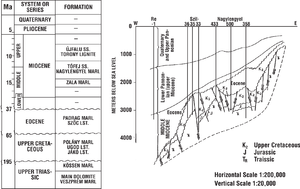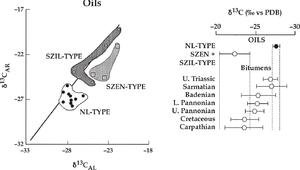Oil correlation case history: Zala basin, Hungary
| Exploring for Oil and Gas Traps | |

| |
| Series | Treatise in Petroleum Geology |
|---|---|
| Part | Critical elements of the petroleum system |
| Chapter | Oil–oil and oil–source rock correlations |
| Author | Douglas W. Waples, Joseph A. Curiale |
| Link | Web page |
| Store | AAPG Store |
The Zala basin, part of the Pannonian basin system in western Hungary, contains oils reservoired in Triassic through Miocene rocks. Clayton and Koncz[1] examined 21 oil samples and 26 core samples from this basin to determine the number of oil families and the presence of source rocks, and to propose oil-source correlations. In this case study we discuss one of those correlations.
Geological setting

The Zala basin consists of various Eocene fault blocks, unconformably overlain by a Middle and Upper Miocene section and underlain by Upper Cretaceous and Triassic rocks.
Figure 1 includes a stratigraphic section (left) of the Zala basin. The Nagylengyel oils are reservoired in Upper Cretaceous and underlying Upper Triassic rocks. A generalized west-to-east stratigraphic section across the Zala basin is shown on the right. Vertical lines are well-bore ties, beginning with the Re-1 well on the west and including three wells of the Szilvágy field and three wells of the Nagylengyel field.
Characteristics of NL oils

The 21 oils can be grouped into at least three families, corresponding roughly to existing fields: the Nagylengyel (NL), Szentgyörgyvölgy (Szen), and Szilvágy (Szil). This article concerns the characteristics and source of the NL oils, which, on the basis of isotopic and molecular criteria (e.g., lack of oleananes), are distinct from the Szen and Szil families. The NL family, reservoired in Upper Cretaceous and Triassic rocks, is characterized by a low pristane–phytane ratio, significant amounts of at least one C24 tetracyclic terpane, and high concentrations of vanadium and nickel. In general, these characteristics suggest a carbonate-rich source rock. Its age, inferred from the absence of oleanane in the oils, may be older than Late Cretaceous, although oleanane is often absent in carbonates due to lack of terrestrial input.
After establishing the NL oils as a single type, Clayton and Koncz[1] determined the source potential for the available sedimentary section using 26 core samples and attempted to correlate the NL oils to each of the possible sources. Just as the first screening step for the oil–oil correlation involved δ13C values of the aliphatic and aromatic hydrocarbons, the first screening step for the oil–source rock correlation effort involved comparing δ13C of the whole oils and bitumens from the source candidates. Their results indicate that two potential sources [the Upper Triassic Kössen Marl and the Sarmatian (middle Miocene) shales] have very similar δ13C values. When these carbon isotope data are combined with oleanane–hopane ratios and C27–C29 sterane distributions, cluster analysis comparison supports a dominantly Upper Triassic source for the NL oils, with possibly a minor contribution from the Sarmatian (middle Miocene) shales.
Figure 2 shows isotope data used to support oil–oil and oil–source rock correlations for the NL oils of the Zala basin. The Sofer plot (left) distinguishes the NL oils from the Szil and Szen types, since the NL oils are significantly lighter isotopically. The data on the right (including data compiled by Koncz[2] show that only the Upper Triassic and Sarmatian (middle Miocene) units are isotopically similar to the NL oils.
Using geological data to refine the correlation
The geological data may refine this oil–source rock correlation still further. As indicated in Figure 2, an Upper Triassic (Kössen Marl) source for the NL oil family is consistent with the occurrence of NL oils in Triassic and Upper Cretaceous reservoirs. In contrast, down-section (and, in some cases, down-structure) migration from a middle Miocene source into an Upper Triassic reservoir, as would be necessary to justify a significant middle Miocene contribution to the NL oil family, is clearly difficult. Furthermore, total organic carbon values and hydrogen indices of the Kössen Marl are greater than those of the Sarmatian (middle Miocene) shales by factors of six and three, respectively, indicating the marl is a much better source unit. Finally, the characteristics of the NL oils are consistent with a source from marlstone, and modeling results presented by Clayton and Koncz[1] suggest that maturation and timing of migration of Kössen-sourced oil is most consistent with placement in Upper Triassic reservoirs.
What this case study illustrates
From this case study, we see that any valid oil–source rock correlation must satisfy the following requirements:
- Be preceded by a successful oil–oil correlation.
- A prior study to establish which sedimentary units in the basin are oil source rocks or possess source rock potential.
- Have at least two of the three major groups of geochemical parameters (elemental, isotopic, molecular) support the positive correlation before it can be considered valid. (In the case of the NL oils, isotopic and molecular data both support the correlation.)
- Be geologically reasonable, with a migration pathway available between source and reservoir at the time migration occurred.
See also
References
- ↑ 1.0 1.1 1.2 1.3 1.4 Clayton, C. J., and M. Bjorøy, 1994, Effect of maturity on 13C/12C ratios of individual compounds in North Sea oils: Organic Geochemistry, vol. 21, p. 737–750, DOI: 10.1016/0146-6380(94)90016-7.
- ↑ Koncz, I., 1990, The origin of the oil at the Nagylengyel and nearby fields [in Hungarian]: Általános Földtani Szemk, vol. 25, p. 55–82.